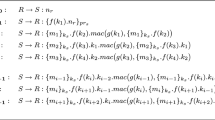Abstract
We present a model-theoretic approach for reasoning about security protocols, applying recent insights from dynamic epistemic logics. This enables us to describe exactly the subsequent epistemic states of the agents participating in the protocol, using Kripke models and transitions between these based on updates of the agents’ beliefs associated with steps in the protocol. As a case study we will consider the SRA Three Pass protocol and discuss the Wide-Mouthed Frog protocol.
Similar content being viewed by others
References
M. Abadi A. Gordon (1999) ArticleTitle‘A calculus for cryptographic protocols: The spi calculus’ Information and Computation 148 1–70 Occurrence Handle10.1006/inco.1998.2740
Abadi, M. and M. Tuttle: 1991, ‘A semantics for a logic of authentication’, in Proc. PODC’91, ACM, pp. 201–216.
Agray, N., W. van der Hoek, and E. P. de Vink: 2001, ‘On BAN logics for industrial security protocols’, in B. Dunin-Keplicz and E. Nawarecki, (eds.), From Theory to Practice in Multi-Agent Systems, LNAI 2296, pp. 29–38.
Anderson, R. J.: 2001, Security Engineering: A Guide to Building Dependable Distributed Systems, Wiley.
A. Baltag (2002) ArticleTitle‘A logic for suspicous players: Epistemic actions and belief-updates in games’ Bulletin of Economic Research 54 1–46 Occurrence Handle10.1111/1467-8586.00138
A. Baltag L. S. Moss (2004) ArticleTitle‘Logics for epistemic programs’, Synthese: Knowledge Rationality and Action 139 165–224
Baltag, A., L. S. Moss, and S. Solecki: 1998, ‘The logic of public announcements, common knowledge and private suspicions’, in Itzhak Gilboa, (ed.), Proc. TARK’98, pp. 43–56.
Bleeker, A. and L. Meertens: 1997, ‘A semantics for BAN logic’, in Proceedings DIMACS Workshop on Design and Formal Verification of Protocols, DIMACS, Rutgers University, http://dimacs.rutgers.edu/Workshops/Security.
M. Burrows M. Abadi R. M. Needham (1990) ArticleTitle‘A logic of authentication’ ACM Transactions on Computer Systems 8 16–36 Occurrence Handle10.1145/77648.77649
Clark, J. A. and J. L Jacob: 1997, ‘A survey of authentication protocols 1.0’, Technical Report, University of York.
D. Dolev A. C. Yao (1983) ArticleTitle‘On the security of public-key protocols’ IEEE Transaction on Information Theory 29 198–208
Gerbrandy, J.: 1997, ‘Dynamic epistemic logic’, Technical Report LP- 97–04, ILLC.
Gerbrandy, J.: 1999, ‘Bisimulations on Planet Kripke’, PhD thesis, ILLC Dissertation Series 1999–01, University of Amsterdam.
Hommersom, A. J.: 2003, ‘Reasoning about security’, Master’s thesis, Universiteit Utrecht.
Kessler, V. and H. Neumann: 1998, ‘A sound logic for analyzing electronic commerce protocols’, in J. -J. Quisquater, Y. Deswarte, C. Meadows, and D. Gollman (eds.), Proc. ESORICS’98, LNCS 1485, pp. 345–360.
Kooi, B.: 2003, ‘Knowledge, Chance, and Change’, PhD thesis, ILLC Dissertation Series 2003–01, University of Groningen.
G. Lowe (1996) ArticleTitle‘Breaking and fixing the Needham-Schroeder public-key protocol using FDR’ Software - Concepts and Tools 17 93–102
Roorda, J.-W., W. van der Hoek, and J.-J. Ch Meyer: 2002, ‘Iterated belief change in multi-agent systems’, in Proceedings of the First International Joint Conference on Autonomous Agents and Multi-Agent Systems: Part 2.
Schneier, B.: 2000, Secrets and Lies: Digital Security in a Networked World, Wiley.
S. G. Stubblebine R. N. Wright (2002) ArticleTitle‘An authentication logic with formal semantics supporting synchronization, revocation and recency’ IEEE Transactions on Software Engineering 28 256–285 Occurrence Handle10.1109/32.991320
van Ditmarsch, H. P.: 2000, ‘Knowledge games’, PhD thesis, ILLC Dissertation Series 2000–06, University of Groningen.
van Ditmarsch, H. P.: 2001, ‘The semantics of concurrent knowledge actions’, in M. Pauly and G. Sandu, (eds.), Proc. ESSLLI Workshop on Logic and Games, Helsinki.
Wedel, G. and V. Kessler: 1996, ‘Formal semantics for authentication logics’, in E. Bertino, H. Kurth, G. Martello, and E. Montolivo, (eds.), Proc. ESORICS’96, LNCS 1146, pp. 219–241.
Author information
Authors and Affiliations
Corresponding author
Rights and permissions
About this article
Cite this article
Hommersom, A., Meyer, Jj. & De vink, E. Update Semantics of Security Protocols. Synthese 142, 229–267 (2004). https://doi.org/10.1007/s11229-004-2247-0
Issue Date:
DOI: https://doi.org/10.1007/s11229-004-2247-0




